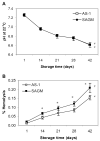In vitro measures of membrane changes reveal differences between red blood cells stored in saline-adenine-glucose-mannitol and AS-1 additive solutions: a paired study
- PMID: 23869602
- PMCID: PMC4173075
- DOI: 10.1111/trf.12344
In vitro measures of membrane changes reveal differences between red blood cells stored in saline-adenine-glucose-mannitol and AS-1 additive solutions: a paired study
Abstract
Background: Saline-adenine-glucose-mannitol (SAGM) and a variant solution, AS-1, have been used for more than 30 years to preserve red blood cells (RBCs). Reputedly these RBC components have similar quality, although no paired study has been reported. To determine whether differences exist, a paired study of SAGM RBCs and AS-1 RBCs was conducted to identify membrane changes, including microparticle (MP) quantitation and in vitro RBC-endothelial cell (EC) interaction.
Study design and methods: Two whole blood packs were pooled and split and RBCs were prepared (n=6 pairs). One pack was suspended in SAGM and one in AS-1. Samples were collected during 42 days of refrigerated storage. RBC shape and size and glycophorin A (GPA)(+) and phosphatidylserine (PS)(+) MPs were measured by flow cytometry. RBC adhesion to ECs was determined by an in vitro flow perfusion assay. Routine variables (pH, hemolysis) were also measured.
Results: Compared to SAGM RBCs, AS-1 RBCs had lower hemolysis (p<0.04), lower GPA(+) MPs (p<0.03), and lower PS(+) MPs (p<0.03) from Day 14 onward. AS-1 RBCs had higher (p<0.02) side scatter from Day 28 onward compared to SAGM RBCs. SAGM RBCs were more adherent to ECs on Day 28 of storage compared to AS-1 RBCs (p=0.04), but reversed on Day 42 (p=0.02).
Conclusion: SAGM RBCs lose more membrane during storage. SAGM RBCs had increased adherence to ECs on Day 28 of storage, while AS-1 RBCs were more adherent on Day 42. The effect of these differences on the function and survival of SAGM RBCs and AS-1 RBCs after transfusion remains to be determined.
© 2013 Australian Red Cross. Transfusion © 2013 American Association of Blood Banks.
Figures




Comment in
-
More data on red blood cell storage could clarify confusing clinical outcomes.Transfusion. 2014 Mar;54(3):501-2. doi: 10.1111/trf.12581. Transfusion. 2014. PMID: 24617585 No abstract available.
References
-
- Hess JR. An update on solutions for red cell storage. Vox Sang. 2006;91:13–9. - PubMed
-
- Hess JR. Red cell changes during storage. Transfus Apher Sci. 2010;43:51–59. - PubMed
-
- Högman CF, Meryman HT. Storage parameters affecting red blood cell survival and function after transfusion. Transfus Med Rev. 1999;13:275–96. - PubMed
-
- Van de Watering Red cell storage and prognosis. Vox Sang. 2011;100:36–45. - PubMed
Publication types
MeSH terms
Substances
Grants and funding
LinkOut - more resources
Full Text Sources
Other Literature Sources
Research Materials
Miscellaneous

